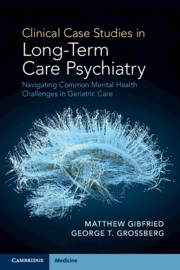 Clinical Case Studies in Long-Term Care Psychiatry
Clinical Case Studies in Long-Term Care Psychiatry Treatment-Resistant Depression and Electroconvulsive Therapy
from Section 2 - Mood Disorders
Published online by Cambridge University Press: 31 October 2024
Major depressive disorder is a serious and life-threatening condition not uncommon to older adults. Only 60-70% of patients respond to an adequate trial of two different antidepressants. Reasonable strategies to address treatment-resistant depression in older adults include adding an antidepressant in another class or adding one or more of many available augmentation agents. When patients have treatment-resistant depression a clinician may need to consider nonpharmacologic therapies for depression such as electroconvulsive therapy or transcranial magnetic stimulation.
To save this book to your Kindle, first ensure [email protected] is added to your Approved Personal Document E-mail List under your Personal Document Settings on the Manage Your Content and Devices page of your Amazon account. Then enter the ‘name’ part of your Kindle email address below. Find out more about saving to your Kindle.
Note you can select to save to either the @free.kindle.com or @kindle.com variations. ‘@free.kindle.com’ emails are free but can only be saved to your device when it is connected to wi-fi. ‘@kindle.com’ emails can be delivered even when you are not connected to wi-fi, but note that service fees apply.
Find out more about the Kindle Personal Document Service.
To save content items to your account, please confirm that you agree to abide by our usage policies. If this is the first time you use this feature, you will be asked to authorise Cambridge Core to connect with your account. Find out more about saving content to Dropbox.
To save content items to your account, please confirm that you agree to abide by our usage policies. If this is the first time you use this feature, you will be asked to authorise Cambridge Core to connect with your account. Find out more about saving content to Google Drive.